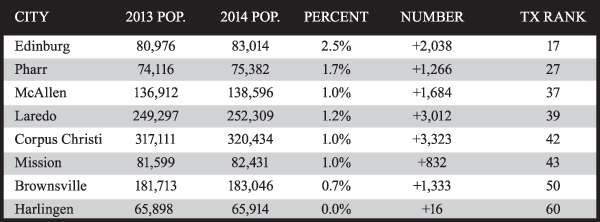- La Feria Community Holds Succesful Business Mixer Event
- Little Nashville to Take Place in Downtown Mercedes
- Lions Basketball Captures District Gold
- La Feria ISD Students Compete in Regional Chess Tournament
- Lions End First Half of 32-4A on a High Note
- La Feria ISD Held Another Successful Parent Conference
- Strong Appearance for Lions at Hidalgo Power Meet
- LFECHS Students Get to Meet Local Actress
- Students Participate in Marine Biology Camp
- Two LFECHS Students Qualify for All-State Band
Rio Grande Valley Cities Keep Growing
- Updated: June 12, 2015

Box of Oranges, from the Lower Rio Grande Valley, Texas (postcard, c. 1912-1924)
Edinburg, Pharr, McAllen, Mission and Brownsville all add hundreds
RIO GRANDE VALLEY (June 2, 2015) – Rio Grande Valley cities continue to grow and add population although not nearly as fast as power suburbs around Texas’ major metro areas, according to the most recent US Census’ annual estimates of resident population for cities above 50,000.
Edinburg was the Rio Grande Valley’s fastest growing city from 2013 to 2014 according to the Census’ estimates and calculations expanding at 2.5% for the best population growth rate south of San Antonio for a city above 50,000. Edinburg added 2,038 people and now sits at an estimated population of 83,014.
Pharr, McAllen and Mission were all closely behind as cities in Hidalgo County grew faster than their neighbors in Cameron. Pharr was the second-fastest growing large city in the RGV, up 1.7% and 1,266 residents to 75,382, while McAllen – the largest city in Hidalgo County by far – grew by 1.0% and added 1,684 people to reach 138,596.
“With lower unemployment, new companies coming into the Valley and the building and retail sectors up, it’s natural most cities would be up in population, too,” said Julian Alvarez, CEO of the Rio Grande Valley Partnership. “This is great news but challenging as well. We have to work together as a region to meet these new growth challenges like how we provide transportation, jobs and education.”
Brownsville and Harlingen in Cameron County saw little growth percentage-wise, but Brownsville did manage to add more than 1,300 new residents. In the South Texas region, Laredo and Corpus Christi each added just over 3,000 people. In Texas, San Marcos was the state and nation’s fastest growing city for the third straight year up 7.9% over 2013.
The US Census performs a decennial count every 10 years and the next one will be in 2020. It will continue to provide annual estimates until that time. No other Valley cities other than the seven listed in the chart below have populations above 50,000.



